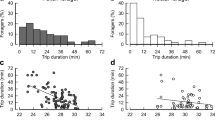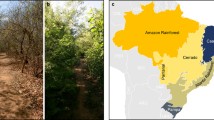Abstract
The objective of this study was to evaluate the temperature sensitivity of three stingless bee species, one from the tropical highland transition Neartic-Neotropical region (Melipona colimana) and two from the tropical lowland regions (Melipona beecheii and Scaptotrigona hellwegeri) of Mexico. The changes in thoracic temperature, behavior, and mortality rate of workers and pupae of the three species submitted to control high and low temperatures were assessed. Workers of highland M. colimana regurgitated water and fanned their wings when submitted to high temperatures, a behavior reported here for the first time in a stingless bee. M. colimana consumed syrup and increased its thoracic temperature in response to cold environment. Workers and pupae of M. colimana experienced lower mortality rates than M. beecheii and S. hellwegeri. The results of this study showed the tolerance of M. colimana to a wider temperature range, possibly as a response to extreme conditions in its native environment. The implications of thermal susceptibility differences for the conservation of highland and lowland stingless bees are discussed.





Similar content being viewed by others
References
Ayala, R. (1999) Revisión de las abejas sin Aguijón de México, (Hymenoptera: Apidae: Meliponini). Fol Entom Mex 106, 1–123
Cauich, O., Quezada-Euan, J.J.G., Macias-Macias, J.O., Reyes-Oregel, V., Medina-Peralta, S., Parra-Tabla, V. (2004) Behaviour and pollination efficiency of Nannotrigona perilampoides (Hymenoptera: Meliponini) on greenhouse tomatoes (Lycopersicon esculentum) in subtropical Mexico. J Econ Entomol 97, 475–481
CONAGUA (2007a) Archivos Observatorio Metereologico Regional de Merida. Comision Nacional del Agua. Yucatan, Mexico.
CONAGUA. (2007b) Observatorio Metereologico Regional, archivos Zona Sur de Jalisco, Comisión Nacional del Agua, Cd. Guzman, Mpio de Zapotlán el Grande. Jalisco. Mexico.
Deutsch, A.C., Tewksbury, J.J., Huey, B.R., Sheldon, S.K., Ghalambor, K.C., Haak, C.D., Martin, R.P. (2008) Impacts of climate warming on terrestrial ectotherms across latitude. Proc Natl Acad Sci 105, 6668–6672
Dias, M.O.J., Aparecido, P.E. (2004) Capacidade de resistencia a altas e baixas temperaturas em operarias de Scaptotrigona postica (Latreille) (Hymenoptera, Apidae) durante os períodos de verãoe inverno. Rev Bras Zool 21, 893–896
Dyer, F.C., Seeley, T.D. (1991) Nesting behavior and the evolution of worker tempo in four honey bee species. Ecology 72, 156–170
Engels, W. (1988) Fortpflanzungsstrategien bei Bienen. Reproductive strategies in bees. Verh Dtsch Zool Ges 81, 155–167
Engels, W., Rosenkranz, P., Engels, E. (1995) Thermoregulation in the nests of the neotroprical stingless bee Scaptotrigona postica and a hypothesis on the evolution of temperature homeostasis in highly eusocial bees. Stud Neotrop Fauna Environ 30, 193–205
Fletcher, D.J.C., Crewe, R.M. (1981) Nest structure and thermoregulation in the stingless bee Trigona (Plebeina) denoti Vachal (Hymenoptera: Apidae). J Entomol Soc South Afr 44, 183–196
Frazier, M.R., Huey, R.B., Berrigan, D. (2006) Thermodynamics constrains the evolution of insect population growth rates: “Warmer is better”. Am Nat 168, 512–520
Ghalambor, C.K., Huey, R.B., Martin, P.R., Tewksbury, J.J., Wang, G. (2006) Are mountain passes higher in the tropics? Janzen’s hypothesis revisited. Integr Comp Biol 46, 5–17
Gurel, F., Gosterit, A., Eren, O. (2008) Life-cycle and foraging patterns of native Bombus terrestris (L.) (Hymenoptera: Apidae) in the Mediterranean region. Insect Soc 55, 123–128
Heinrich, B. (1993) The hood blooded Insects: strategies and mechanisms of thermoregulation. Springer Verlag, Germany
Huey, R.B., Stevenson, R.D. (1979) Integrating thermal physiology and ecology of ectotherms: Discussion of approaches. Am Zool 19, 357–366
Janzen, D.H. (1967) Why mountain passes are higher in the tropics. Am Nat 101, 233–249
Jones, C.J., Oldroyd, P.B. (2007) Nests thermoregulation in social insects. In: Simpson, S.J. (ed.) Advances in Insect Physiology, pp. 154–185. Elsevier, Oxford
Jones, C.J., Helliwell, P., Beekman, M., Maleszka, R., Oldroyd, P.B. (2005) The effects of rearing temperature on developmental stability and learning and memory in the honeybee Apis mellifera. J Comp Physiol 191, 1121–1129
Mardan, M., Kevan, G.P. (2002) Critical temperatures for survival of brood and adult workers of the giant honeybee Apis dorsata (Hymenoptera: Apidae). Apidologie 33, 295–301
Mc Mullan, J.B., Brown, M.J.F. (2005) Brood pupation temperature affects the susceptibility of honeybees (Apis mellifera) to infestation by tracheal mites (Acarapis woodi). Apidologie 36, 97–105
Moritz, R.F.A., Crewe, R.M. (1998) Air ventilation in nests of two African stingless bees Trigona denoiti and Trigona gribodoi. Experientia 44, 1024–1027
Nogueira-Neto, P. (1997) Vida e criação de abelhas indígenas sem ferrão. São Paulo, Brasil
Ortiz-Mora, A., Van Veen, J.W., Corrales-Moreira, G., Sommeijer, M.J. (1995) Influence of altitude on the distribution of Stingless bees (Hymenoptera: Apidae: Meliponinae). Apiacta 30, 101–105
Proni, E.A., Hebling, M.J.A. (1994) Tolerance to temperature variation in workers of Tetragonisca angustula fiebrigi Schwars, 1938 and Tetragonisca angustula angustula Latreille, 1807 (Hymenoptera: Apidae). Rev Bras Biol 54, 85–90
Roubik, D.W. (1983) Nest and colony characteristics of Stinglees bees from Panama (Hymenoptera: Apidae). J Kans Entomol Soc 55, 789–800
Roubik, D.W. (2006) Stingless bee nesting biology. Apidologie 37, 1–20
Roubik, D.W., Peralta, A.F.J. (1983) Thermodynamics in nests of two Melipona species in Brazil. Act Amaz 13, 453–466
Sakagami, S.F. (1982) Stingless bees. In: Herman, H.R. (ed.) Social Insects, pp. 36–423. Academic, London
Schmolz, E., Lamprecht, I. (2004) Thermal investigations on social insects. In: Lorinczy, D. (ed.) The Nature of Biological Systems as Revealed by Thermal Methods, pp. 251–283. Kluwer Academic, The Netherlands
Seeley, T.D. (1995) The wisdom of the hive. Harvard University Press, Cambridge
Seeley, T.D., Heinrich, B. (1981) Regulation of temperature in the nest of social insects. In: Heinrich, B. (ed.) Insect Thermoregulation, pp. 159–234. Wiley, New York
SPSS. (2006) Statistical Package for the Social Sciences, SPSS for windows. SPSS, Inc., Chicago
Statistical Graphics Corp. (1999) Statgraphics Plus for Windows 4.1 Copyright. Statistical Graphics Corp., Princeton
Tautz, J. (2008) The buzz about bees: Biology of a superorganism. Springer-Verlag, Berlin
Tautz, J., Maier, S., Groh, C., Rossler, W., Brockmann, A. (2003) Behavioral performance in adults honeybees is influenced by the temperature experienced during their pupal development. Proc Natl Acad Sci 100, 7343–7347
Velthuis, H.H.W. (2002) The historical background of the domestication of the bumble-bee Bombus terrestris and its introduction in agriculture. In: Kevan, P., Imperatriz-Fonseca, V.L. (eds.) Pollinating Bees: The Conservation Link Between Agriculture and Nature, pp. 177–184. Ministry of Environment, Brasilia
Wille, A. (1983) Biology of stingless bees. Annu Rev Entomol 28, 42–46
Zar, J. (1999) Biostatistic analisis. Prentice Hall, New York
Zucchi, R., Sakagami, S.F. (1972) Capacidade termo-reguladora em Trigona spinipes e em algumas uotras espécies de abelhas Sem Ferrão (Hymenoptera: Apidae: Meliponinae). In: Hebling, S.P., Lello, E., de Takahashi, C.S. (eds.) Homenagem a Warwick Estevam Kerr, Brasil, pp. 301–310
Acknowledgments
The authors would like to thank people who have contributed to this work, especially to Angelica Farias S, Jalil Fallad and Judith Hueso. To SEP-Conacyt project 103341 “Conservacion de las abejas sin aguijon de Mexico (Hymenoptera: Meliponini): Identificacion de especies cripticas e indicadores de diversidad genetica” and Conacyt-Promep for the financial support granted to J. Octavio Macías-Macías to achieve a doctoral degree at the Universidad Autonoma de Yucatan, and to Bernardo Soto and Gustavo Alcazar and to the Centro Universitario del Sur (CUSUR) of the Universidad de Guadalajara for providing facilities in which the experiments were conducted.
Author information
Authors and Affiliations
Corresponding author
Additional information
Manuscript editor: Stan Schneider
Comparaison de la tolérance à la température chez des espèces d’abeilles sans aiguillon des hautes et basses terres tropicales du Mexique; implication pour leur conservation (Hymenoptera: Apidae: Meliponini)
Melipona/ Scaptotrigona/ Apidae/ tolérance à la température/ comportement/ forêt tempérée/ Mexique
Temperaturtoleranz von stachellosen Bienen aus den tropischen Hochländern und den Tieflandgebieten in Mexiko im Vergleich, und ihre Konsequenzen für den Artenschutz (Hymenoptera: Apidae: Meliponini)
Melipona / Scaptotrigona / Apidae/ Temperaturtoleranz/ Verhalten/ Wald der gemäßigten Zonen / Mexiko
Rights and permissions
About this article
Cite this article
Macías-Macías, J.O., Quezada-Euán, J.J.G., Contreras-Escareño, F. et al. Comparative temperature tolerance in stingless bee species from tropical highlands and lowlands of Mexico and implications for their conservation (Hymenoptera: Apidae: Meliponini). Apidologie 42, 679–689 (2011). https://doi.org/10.1007/s13592-011-0074-0
Received:
Revised:
Accepted:
Published:
Issue Date:
DOI: https://doi.org/10.1007/s13592-011-0074-0




